AlexPro9500/iStock/GettyImages
There aren't many foods that demonstrate the virtues of slow cooking more clearly than ribs. If they're simply unwrapped and thrown on a grill until they reach a food safe temperature, they're inedibly tough and stringy. Yet if they're slow-cooked on that same grill for a period of hours, they become memorably tender and lushly flavored. Many cooks parboil their ribs to speed the cooking process, but it's not an ideal solution.
How Smoke-Roasting Works
The traditional way to cook ribs is over a charcoal fire with some hardwood chips added for a suitably smoky flavor. An electric smoker or gas grill won't provide exactly the same result, but in skilled hands it comes pretty close. The trick is to cook the ribs slowly enough to prevent the muscle fibers from contracting in the heat and toughening. That usually requires a temperature between 200 and 250 degrees Fahrenheit. Second, the ribs' internal temperature must rise into the 180 F-to-200 F range. That's the point at which the tough connective tissues between the ribs melt and become lush, tender and gelatinous.
What Parboiling Does
Since simmering tough meats tenderizes them in much the same way as roasting, and also serves to raise the internal temperature of the rack, parboiling the ribs is an obvious and intuitive way to shorten the cooking process. It also has the unfortunate effect of leaching away much of their flavor. Many of the flavor compounds in pork or any other meat are water-soluble, which is why simmering them produces a rich broth for soups or sauces.
Other Shortcuts
If you're committed to ribs for dinner and time constraints are looming, there are better ways to shorten the cooking time of your ribs. If you have a large pot and a steamer insert, or a family-sized commercial steamer, steam the ribs instead for a half-hour. The ribs will retain most of their flavor and texture, and it takes about an hour from your cooking time. Alternatively, cut the racks into pieces that will fit in your microwave and cook them at half-power until they're grey and beginning to ooze juice. That will also shorten your cooking time.
Advance Preparation
The most useful cheat of all is to slow-roast your ribs ahead of time in your kettle barbecue or electric smoker, cooking them until they're perfectly tender but without applying the final coat of sauce. Cool the ribs quickly in a breezy location, then wrap them tightly and refrigerate them. The next day, take them out a half-hour early and let them warm at room temperature. Then grill them quickly to bring them back up to temperature, brushing on your preferred sauce during the last few minutes. Their texture should be almost as good as when they're first cooked, and their flavor will be richer because of the overnight refrigeration.
Related Articles
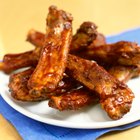
How to Bake Spare Ribs Before BBQing
Do I Cook Ribs Before Putting Them on ...
How Long Should You Boil Spareribs ...
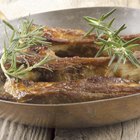
How to Sear Ribs
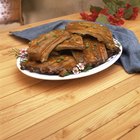
How to Heat Up Smoked Pork Ribs

How to Cook Wild Boar Ribs

How to Barbecue Ribs With a Gas Grill

How to Cook Pork Ribs on a Propane Grill
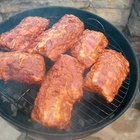
How to Smoke Ribs With a Gas Smoker
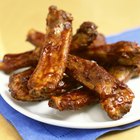
How to Quickly Cook Fork-Tender Ribs
Do You Drain the Marinade Before ...
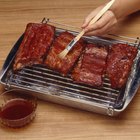
How Long Can You Cook Beef Ribs at 300 ...

The Best Way to Cook Pork Shoulder Ribs ...

How to Cook Wild Boar Ribs
Baking Buffalo Ribs in Foil
How Long Can You Marinate Meat Before ...
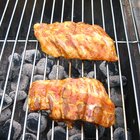
How Do I Cook Spare Ribs in an Electric ...

What Kind of Beer Is Good to Marinate ...
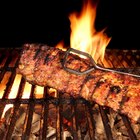
How to Cook Marinated Beef Back Ribs

Do You Need to Cover Ribs When Baking?
References
- On Food and Cooking: The Science and Lore of the Kitchen; Harold McGee
- On Cooking: A Textbook of Culinary Fundamentals; Sarah Labensky, et al.
- Amazing Ribs: Last Meal Ribs -- The Best Barbecue Ribs You've Ever Tasted!
Writer Bio
Fred Decker is a trained chef and prolific freelance writer. In previous careers, he sold insurance and mutual funds, and was a longtime retailer. He was educated at Memorial University of Newfoundland and the Northern Alberta Institute of Technology. His articles have appeared on numerous home and garden sites including GoneOutdoors, TheNest and eHow.